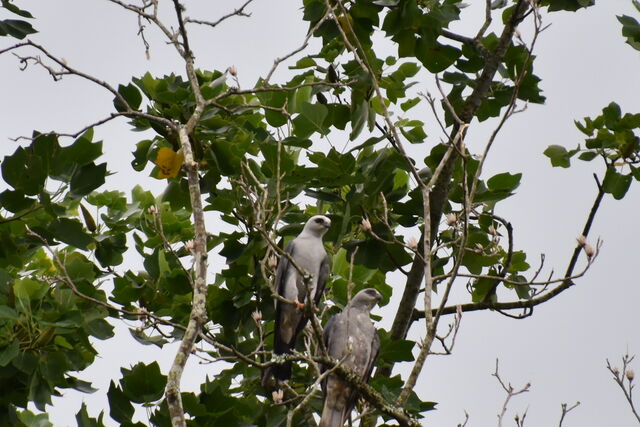

One reliable spot for these flocks is in the Glennville area (west of Savannah), specifically the Skeens Farm. In late summer, they team up with Swallow-tailed Kites to form foraging flocks. They like to nest along the edges of expansive bottomland forests of many of the larger Coastal Plain rivers, in large forest tracts near pastureland, and in some smaller forested areas near cities/towns, according to the Breeding Bird Atlas of Georgia. In Georgia, Mississippi Kites are more common in the coastal plain and on the coast rather than in the Piedmont.

Adults feed them for at least eight weeks after hatching. The young may climb out of the nest onto nearby branches when about four weeks old and make their first flights at about five weeks. First they may feed the nestlings mostly insects, regurgitated into the nest, with larger prey coming later. The female lays one to two white eggs, and incubation is by both parents for 29 to 31 days. Adults add greenery throughout the season. The nest, built by both sexes, is a rather flimsy platform of dead twigs, lined with green leaves. Nesting tends to be in loose colonies, with the site in a tree usually near the edge of woodlot 20 to 35 feet above ground, although it can be up to 140 feet. The tail is fairly long and square-tipped. In size, they’re between a crow and a goose and have long, pointed wings. Juveniles are streaky, with brownish chests and underwings, and have banded tails. The coloration of this bird is a mix of gray and black, becoming pale gray-white on the head and in the secondaries of the wings. Except during migration, you’re unlikely to see one in metro Atlanta. In the winter they take off for the interior of South America. During the breeding season they are most common in southern South Carolina, Georgia, and Alabama and on the Great Plains of Texas, Oklahoma, and Kansas. It won’t turn up its beak at road-kill either.ĭespite the name, they aren’t particularly associated with the state of Mississippi or the Mississippi River. Major items in the diet include cicadas, grasshoppers, katydids, beetles, and dragonflies it also eats moths and bees, and lesser numbers of frogs, toads, snakes, bats, rodents, small birds, and turtles. It can also skim low to catch prey on or near the ground. When this bird isn’t flying just for fun, it can catch large flying insects high in the air, often holding them with one foot and eating them while on the wing. The printed page cannot adequately describe the aerial maneuvers these birds can perform, but if you’d like to see for yourself, search “Mississippi Kite Barrel Roll” on YouTube for a demonstration. If they were military pilots, they might be the Blue Angels. If Mississippi Kites were circus performers, they might be the Flying Wallendas.

By Steve Phenicie, Georgia Audubon member


 0 kommentar(er)
0 kommentar(er)
